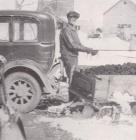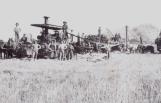2
Visits to Mather a few years ago enable me to say there are many similarities between the community of the 1920's I knew as a boy and that of today. Not surprisingly, though, there are many sharp contrasts.In view of the fact Mather railway station (no longer in existence) was my home, it is not remarkable that one of the contrasts most obvious to me lies in transportation.
4
There were cars "back then" of course, but they were elemental and not every household had one. Even at the end of the decade the long distance auto trip was not anywhere near to being the commonplace it is today. There was neither bus nor truck service.The railway station was still the community's contact point with the outside world. Passenger trains ran east and west six days a week. Way freights ran regularly in each direction. The mail came and went by train and many telegrams were received and dispatched.
On the farms, the mechanical challenge to horses was barely underway. Horses still did nearly all field work. Trucks were rare. A wagon load of grain on the way to elevator row was the common sight. Every farm had a buggy or democrat.
6
In winter the dominance of horses in the community, and of the railway station as a door on the outside world, was likely absolute, Cars did not operate in the winter unless weather was unusually favorable. Horse-drawn cutters, jumpers, vans and sleighs took over for the duration.There appeared to be some competition in vans - closed-in vehicles sometimes on bob sleighs. sometimes on a single set of runners. Some were very smart in appearance. A stove was a prized convenience in a proportion of them. A Melvin van was the smartest one in the community that I can recall.
8
Horses influenced town facilities and services. Hitching rails for horses stood on Main Street Neil McKenzie's livery barn (a hotel for horses) was an integral part of the community. So was George Jamieson's harness (and shoe repair) shop. Two exciting places for a boy were Archie Hill's and Art Douglas 's blacksmith shops. It was intriguing to watch the shoeing of a horse or the setting of a wagon wheel tire.10
Several steam-powerd threshing outfits still made their rounds at harvest time, each accommodating a number of farmers in succession. It was a tremendous thrill for a town boy to stand beside an operating steamer and to watch the fireman load the flaming firebox with straw. From town, one could often hear whistle signals from several different outfits.Those visits to the farm had a deeper meaning than I realized at the time. Mather and district constituted an integrated community. There was no "fence" at the outskirts of town separating urban and rural dwellers. My impression is that it is much the same today, and if so a gratifying fact remains. With many communities, it is not so.
In appearance the school was basically the same as it is now, except for the comparative newness of the 1920's, and the addition made in more recent years. But then it accommodated grades one to eleven, and I can recall no dearth of students. Teachers changed frequently in those days.
I recall the excitement when No. 3 highway was finally graveled after being graded past Mather. I believe it was only eighteen feet in width but the improvement seemed to mark the beginning of a new era in transportation. Because most roads were not graveled, rain was a real motoring hazard. In the district, prairie trails were still predominant.
Then there was the night robbery at the Bank of Toronto, a totally unexpected event for the little centre, and enough for everyone to talk about it for days. My strongest memory is of the telegraph wires cut by the robbers and watching my father make a repair. The bank closed.
12
In winter the old rink with one curling sheet up the centre was a busy place. The town paused for the annual bonspiel, and battles with rinks from neighboring towns were warmly contested. Skaters circled the curling ice in a rather monotonous pattern, though nobody really complained. Of course, hockey was an impossibility.The "Big Hill," or "Elliott's Hill," was the common sleighing and tobogganing site for children - and the occasional group of older "children." It amazes me now that it could ever have been called the "big hill". Creating snow caves in snow-banks along the railway right-of-way west of the station often engaged the attention of myself and other boys.
A trip to Rock Lake was always an event. Usually we went to the Elliott-Hill resort on the south side, where we camped for a week one summer. Occasionally our family made the longer trip to Avery's on the north side. It was there I saw my first airplane I remember, a barnstorming crate which now certainly would not attract the passengers it did that day. Airplanes were a rarity in the air over Mather in the 1920's. None ever landed, as far as I know.
The Grove, west of the big hill, with its fine trees, was sometimes a picnic spot. I distinctly recall one such event. My favorite memory of it concerns home-made ice-cream made from real cream. My mouth waters.
I remember the trip to Cartwright for the celebration of the 60th anniversary of Confederation. Mather school took part in the parade there. To mark the anniversary, bronze plaques of the Fathers of Confederation were presented to schools, throughout Canada I presume. Does one hang on a Mather school wall today?
I could go on and on, so many memories come flooding in as I write. But already I have probably claimed far too much space. Suffice it to say now that Mather community was a fine one in which to spend early years, and that to this day I feel a strong attachment to my boyhood home.





